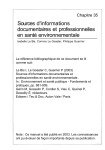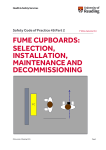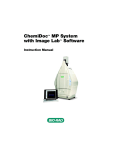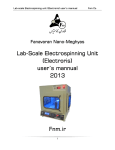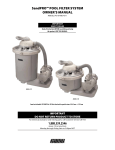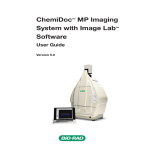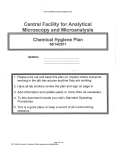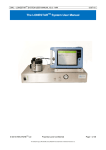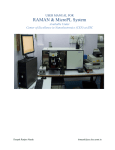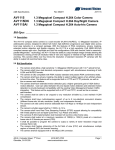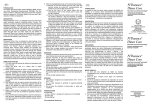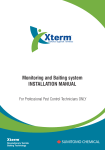Download Chemical Safety (II) Waste Management & Emergency Response
Transcript
Chemical Safety (II) Nanosafety, Waste Management & Emergency Response Dr Samuel Yu Health, Safety and Environment Office (HSEO) HKUST Important Reminder Safety training courses provided by HSEO only cover BASIC safety principles. Your supervisor is responsible for your job-specific safety training, including operational safety procedures, departmental safety policies, etc. 2 Presentation Outlines Nanomaterials and nanosafety Chemical waste legal requirements HKUST chemical waste procedures Incidents and lessons learned Waste minimization Hazardous Material Inventory Emergency response Information Source 3 Nanomaterials & Nanosafety 4 Different Nano-Related Materials Materials with engineered nanostructure, e.g. zeolite with designed pore features Silicon-based nanomaterial or nanostructure, e.g. nanoelectronics Nanomaterials with one dimension not in nanoscale (i.e. >100 nm), e.g. nanotube Nanoparticles (diameter <100 nm) 5 Origins of Nanoparticles Naturally occurring, e.g.volcanic activities, wild fires Anthropogenic incidental nanoparticles, e.g. engines, incinerators Also known as ultrafine particles, <100 nm in AED Engineered nanoparticles At least one dimension <100 nm Relatively uniform in size, monodispersed 6 Unique Properties of Engineered Nanoparticles Novel physicochemical properties not found in parent materials Much higher reactivity, both chemical and biological Precisely designed molecules for specific purposes 7 Buckyballs (C60) Extremely stable Can trap other atom or molecule inside Possible application Superconducting material Drug delivery system Lubricant Catalyst 8 Carbon Nanotubes Field emitters in flat plane display 100X strength, 1/6 weight of steel, mechanically stronger materials Ultra-miniaturized electronics, one candidate of nonsilicon microchips 9 Metal and Metal Oxide Nanoparticles TiO2 for photochemical oxidation, self-cleaning paints, etc ZnO in cosmetics, sunblock Fe for oxidation of contaminants in groundwater CuO for antimicrobial agent Fe2O3 as contrast agent for MRI 10 Quantum Dots (Q-Dots) Nanoparticles of semiconducting materials Size so small it interfere with quantum behavior of atoms Display tunable absorption and emission spectrum over visible wavelength Strong potential for medical imaging CdSe core with ZnS Shell 11 12 Biological Effects Ultra small size Easy penetration Fast distribution Direct interaction with organelles Huge surface areas Increased chemical activities (catalyst) Increased biological activities 13 Two-Sided Sword Beneficial uses Diagnostic (imaging, sensor) Therapeutic (drug delivery) Biomedical research Adverse health effects Rapid uptake thru skin & epithelial cells Translocation along neurons Novel or amplified toxicity Oxidative stress 14 Preliminary Toxicological Data Buckyballs caused lipid peroxidation in fish brain at 500 ppb for 48 hr Nanosize TiO2 toxicity increased, proportional to surface area SWNT causes oxidative stress: free radical formation, depletion of antioxidants Metal impurity may also add toxicity Physical dimensions of some NT may cause pulmonary fibrosis and cancer similar to asbestos 15 A Series of Concerns Research safety Occupational safety Consumer safety Environmental impact 16 Nanoresearch at HKUST Fullerenes Generation by Arc Discharge Reaction Chamber Graphite Rods and Powder 18 Purification of Fullerenes 19 Derivatization of Nanofiber 20 Carbon Nanotube by Chemical Vapor Deposition 21 Nano-sized Zinc Oxide 22 Iron Platinum Nanoparticles 23 Synthetic Zeolite Hydrated alumino-silicate, porous material Both natural and synthetic Porous structure allow interesting chemistry Synthesis can be fine-tuned to produced desired nanostructure Potential applications as catalyst, fuel cell etc 24 Synthetic Zeolite 25 Other Nanomaterials Nano-Composites Nanosized material e.g. CaCO3 added to polymer as filler Carbon nanofiber added to polymer to increase strength Silicon Nanowire Silicon nanowire grown on substrate Process under vacuum 26 Quantum Dots Quantum Dots conjugate used as fluorescence label Xenopus muscle cells grown on circular coverslip Advantage: Qdot does not “bleach” over time like traditional http://probes.invitrogen.com/products/qdot/ overview.html fluorescence 27 Elements of Nanosafety Program at HKUST Nano, or Otherwise… 29 Scope of Nanosafety Program Nanoparticles (d<100 nm) & nanomaterials with one extended dimension, e.g. nanotube, nanowire, nanofiber Nanocomposite, e.g. CaCO3/PP composite Materials with engineered nanostructure, e.g. zeolite with designed nano-size pores Silicon-based nanostructure, nanoelectronics Nano-enabled products “Nano-stuff” 30 Preliminary Nanosafety Program at HKUST Safety input to Nanolab facility Nanosafety in research proposal review Nanomaterial database Assessment of exposure potentials Nanosafety training and chapter in Safety Manual Precautionary measures Monitoring of nano-EHS development 31 Precautionary Measures for HKUST Researchers Mainly for engineered nanoparticles Key references Approaches to Safe Nanotechnology: An Information Exchange with NIOSH. National Institute for Occupational Safety and Health, July 2006. http://www.cdc.gov/niosh/topics/nanotech/safenano/pdf s/approaches_to_safe_nanotechnology_28november200 6_updated.pdf Nanoscience and nanotechnologies: opportunities and uncertainties. The Royal Society & Royal Academy of Engineering, July 2004. http://www.nanotec.org.uk/finalReport.htm 32 Precautionary Measures—Risk Assessment Nanomaterials possess unique physical chemical properties, should be considered as “new chemicals” Treat as potentially hazardous MSDS of raw material can only be viewed as a starting point at best Carbon: practically non-toxic; buckyballs: oral LD50 300 mg/kg 33 Precautionary Measures— Airborne Particles (1) Avoid aerosol generation Many NPs generated in labs under contained conditions NPs tend to agglomerate However, many attempts to disperse NPs for various applications Suspended fine powder can become a fire and explosion hazard Do not allow escape into environment Intentional release into environment must show benefits clearly outweighing risks 34 Precautionary Measures— Airborne Particles (2) Use local exhaust ventilation Fumehood Biological safety cabinets Pharmaceutical hoods Use HEPA Air treatment Protection of personnel 35 Can HEPA Filter Capture Nanoparticles? Theoretically efficiency increase with decreasing size below 0.1-0.3 µm Previously confirmed by data point down to 0.01 µm (10 nm) Recent study by U Minn confirmed HEPA filtration efficiency down to 24 nm, no thermal rebound observed Nanoparticles tend to agglomerate, instead of existing as single particles 36 Particle Size and Filtration Efficiency 37 HEPA Filtration Efficiency Corona Virus POLLENS Flu Virus Common Particle Size Distribution HUMAN SKIN CELL BACTERIA MYCOBACTERIUM TUBERCULOSIS TOBACCO SMOKE VIRUSES ATMOSPHERIC DUST Velocity = 0.013 m/s 100.00 Collection Efficiency 99.99 [%] Velocity = 0.024 m/s Velocity = 0.035 m/s 99.98 99.97 99.96 99.95 0.001 Based on measurement Extrapolated curves 0.01 Extrapolated curves 0.1 1 10 Particle Size [µm] 100 38 SEM of Fibrous Filter 1000 x Used Filter New Filter 39 SEM of Fibrous Filter 10000 x Used Filter New Filter 40 Precautionary Measures— Liquid Solution/Suspension Avoid aerosol generation Avoid skin contact Use gloves at least protective against carrier solvent Do not allow escape into environment Intentional release into environment must show benefits clearly outweighing risks 41 Precautionary Measures— Waste Disposal Treat as chemical waste as a minimum Seek to remove from waste stream or destruct nanofeature as far as practicable 42 Quantum Dots Toxicity “We have not investigated the toxicity of the Qdot® streptavidin conjugate. The materials are provided in a solution which is ~2 mM total Cd concentration; however, the CdSe core is encapsulated in a shell of ZnS and the polymer shell, which may prevent dissolution of free Cd. We have demonstrated the utility of these materials in a variety of live-cell in vitro labeling experiments, but do not have systematic data investigating the toxicity of the materials to humans, to animals, or to cells in culture.” Source: Qdot Streptavidin Conjugates User Manual, Intrivogen 43 Quantum Dots Disposal “The Qdot® conjugate contains cadmium and selenium in an inorganic crystalline form. Please dispose of the material in compliance with all applicable local, state, and federal regulations for disposal of these classes of material. For more information on the composition of these materials, consult the Material Safety Data Sheet.” Source: Qdot Streptavidin Conjugates User Manual, Intrivogen 44 Qdot Destruction Experiment Tried different concentrations of HCl and HNO3 to dissolve Qdots Use fluorescence wavelength under microscope to verify destruction May need to use TEM as confirmation Disposed as waste metal solutions may not destruct nano-feature 45 Acid-Treated QDot Solution 46 Precautionary Measures— Minor Spill Response Treat as hazardous material spill Evacuate area, wait 20 minutes to allow aerosols to settle Don respirator, gloves and coverall Remove spilled dry nanomaterials by HEPA vaccum cleaner Use normal sorbent materials for spilled liquid containing nanomaterials Contact HSEO for major spill 47 Legal Framework for Chemical Wastes What Is Hazardous Waste? Chemical wastes Biological/infectious wastes Medical/clinical wastes Radioactive wastes Co-contaminated wastes 49 A Wrong Way to Deal with Hazardous Waste 50 Chemical Waste Regulations in HK Waste Disposal (Chemical Waste) (General) Regulations of 1992 Set up a waste treatment facility Prohibition of disposal into sewer Registration of waste generators Packaging, labeling and storage of chemical waste Documented collection and disposal scheme 51 Penalties for Chemical Waste Violations (1) Section of Offence the Regulation 6 Failing to register as a waste producer 8 9-11, 13-15 Maximum Penalty $200,000 plus 6 months imprisonment Failing to arrange for proper disposal of waste $200,000 plus 6 months imprisonment Failure to comply with waste packaging & storage requirements $100,000 plus 6 months imprisonment 52 Penalties for Chemical Waste Violations (2) Section of the Regulation 12, 18 37 17 Offence Failure to comply with labeling and warning requirements Furnishing false information Maximum Penalty $50,000 plus 6 months imprisonment $200,000 plus 6 months imprisonment 1st offence - $50,000 Failure to notify in 2nd offence - 100,000 relation to "Part A" waste or to comply with plus $500/day any given directions 53 Legal Definition of Chemical Waste Chemical Waste is legally defined by reference to a list of substances and chemicals in Schedule 1 of the Waste Disposal (Chemical Waste) (General) Regulation enacted 18 March, 1992. 54 Items Not Considered to be Chemical Waste Dilute acids and alkalines, if % by weight is less than figures in Appendix A of “A Guide to the Chemical Waste Control Scheme”, HKEPD, Sep 1992. Neutralized salts, not listed in App A. Elemental metals, not listed in App A (e.g., Copper, Iron, Tin, Zinc). Household chemicals used in labs. Apparatus rinsing water or wiping tissue. 55 HKUST policy and program HKUST Safety and Environmental Policy ...The University will assume all reasonable directives possible to protect its appointees, students, facilities, and the environment, placing priority emphasis towards... ...Proper and safe procedures for the use, handling, storage, transport, and disposal of articles, hazardous materials and waste... 57 Chemical Waste Management at HKUST Waste Generators are responsible to: Request the correct waste container from HSEO. Safely put their waste into the waste container. Fill out the Chemical Waste Log Sheet. 58 Chemical Waste Management at HKUST Waste Generators are responsible to: Segregate waste materials in the laboratory. Safely and properly store and maintain all waste within the laboratory. Request collection of waste by HSEO. 59 Chemical Waste Management at HKUST HSEO is responsible to: Provide waste containers and technical assistance to waste generators at HKUST. Transport waste from laboratories to the waste accumulation area. Manage the HKUST waste accumulation area. 60 Chemical Waste Management at HKUST HSEO is responsible to: Prepare hazardous waste for pickup and disposal by the waste contractor. Maintain HKUST hazardous waste records. Liaise with Environmental Protection Department and Enviropace on hazardous waste issues. 61 Chemical Waste Collection Annual Summary Year Quantity of Chemical Waste Liquid (L) Solid (pack) 1994 (Jul-Dec) 2,380 81 1995 10,530 113 1996 14,580 43 1997 20,830 30 1998 28,100 36 1999 29,180 37 2000 28,680 38 2001 31,520 23 2002 41,600 104 2003 38,280 237 2004 40,360 92 2005 33,140 52 2006 42,700 48 2007 35,740 30 62 Chemical waste streams Three Main Types Liquid Chemical Waste picked up by Enviropace Lab Pack Waste picked up by Enviropace Solid Chemical Waste disposal arranged by HSEO 64 Enviropace Chemical Waste Streams (1) Halogenated Organic Solvents Non-halogenated Organic Solvents Organic Acids Inorganic Acids Hydrofluoric Acid Metal Solution Chrome (VI) or Boron 65 Enviropace Chemical Waste Streams (2) Alkalines Cyanides Lubricating Oil Photographic Film Fixer/Developer Gel Waste Phenol Sludge Metal Sludge Rags with Solvent and Oil 66 Chemical Waste Mixtures Select the container according to the MAJOR component of the mixture. Exceptions: Always put halogenated compounds in the “Halogenated Solvents Container” Always put cyanide waste into the “Cyanide” container (Always maintain alkaline, pH>7, to avoid HCN formation) even if these are the minor component in the mixture. 67 Different Chemical Waste Containers Plastic (Acids and Alkalies, Fixer/Developer Carbon Steel (Lube Oil, Other Oils) Metal with inner plastic lining (Halogentated & Non-halogenated Solvents) Plastic, Open top (organic gel) 68 Required Information on Waste Containers Waste generator name and phone number Waste stream name Standard Waste Label with Hazard Warning Symbol(s) A Waste Log Sheet in a plastic folder (for applicable waste streams) 69 70 Hazard Symbols on Chemical Waste Labels 71 Intermediate Waste Containers Intermediate waste containers must be clearly labeled (waste stream, responsible person, contact) Containers that receive multiple sources of waste must have a log Same handling procedures, including logging and compatibility testing If empty reagent bottles are used, they must be thoroughly cleaned 72 Chemical waste procedures Waste Handling Safety Precautions Carefully inspect each container for broken handles or leaks before use. Use appropriate personal protective equipment: splash-proof goggles, face shield, gloves, lab coat, respirator, etc. Use a fume cupboard for waste with hazardous or odorous vapors. Close container tightly after transfer. Be careful handling full containers. 74 75 Waste Handling Procedures Always check liquid level before adding new liquids. Perform compatibility test before adding new liquids. Fill container to no more than 75% of full capacity. For large volume transfers, use funnel. Fill in the chemical waste log sheet immediately. 76 Compatibility Test Procedures (1) Performed inside a fume cupboard, by an experienced person. Fume cupboard must be functioning properly. Transfer 50 mL existing waste from target container to beaker. Place thermometer into beaker. Slowly mix in new chemical waste, to the estimated volumetric ratio. 77 Compatibility Test Procedures (2) If bubbling, fuming, or a temperature increase of >10oC occurs, stop mixing, the wastes are INCOMPATIBLE. If no observable reaction occurs within 5 minutes, the wastes are COMPATIBLE. 78 Chemical Waste Log Sheet Use a dark color permanent ink pen (not pencil, or water-based ink). Use chemical names of reagents and waste (full name in block letters, not abbreviations). Include the volume of waste being transferred. Estimate the percentage of mixture components. 79 The Hong Kong University of Science & Technology Chemical W ast e L og S heet C.W. P. Reg. No.: 9311-831-T2006-01 Waste Type: Department: Room No.: Date (DD/MM/YY) SEPO No.: CWTF-ID: Contact Person: Name of Reactant/ Product/ Waste (Full Name in Block Letter) Quantity Ext: Producer’s Name Phone No. 80 Why is Chemical Waste Log Sheet Important? Requirement of Enviropace: “Every waste entering into a chemical waste container must be properly logged. The filled log sheet must accompany the container at the time of collection by Enviropace. Enviropace will refuse collection of containers that do not carry a legible log sheet.” 81 Why is Chemical Waste Log Sheet Important? To comply with the “Code of Practice on the Packing, Labelling and Storage of Chemical Wastes” issued by the HK Environmental Protection Department. To provide information to Enviropace on the treatment of received waste containers. To provide clues about the compatibility of chemical wastes in container. 82 83 Chemical Waste Storage Use a spill tray / secondary container for spill containment. Keep the waste log sheet current. Every storage area must have a proper chemical waste sign. Store flammable waste in a flammable cabinet wherever possible. 84 85 86 Chemical Waste Collection Procedures Use the HSEO web page, “Request for Chemical Waste Collection”. http://www.ab.ust.hk/hseo/submenu/waste.htm Waste collection service by HSEO is on Tuesday, or the next working day if Tuesday is a holiday. Users should make a pickup appointment if a collection site is unattended. 87 Lab-Pack Program Highly reactive chemicals, water reactive chemicals, including conc. strong oxidizing or reducing agents Waste that cannot pass the compatibility test Unwanted or expired chemicals Disposed of in original containers Valuable for labs, unfortunately program not running well due to cost 88 Current Lab Pack Practice Generator produce list of chemicals need to be disposed EPD/Enviropace review list then give advice: Dissolve/dilute chemical then put in suitable liquid chemical waste stream Put originally packaged chemical in specified standard waste container Enviropace pick up in regular rounds 89 90 91 92 93 Solid Chemical Wastes Elemental mercury waste, periodically collected by Enviropace (Don’t use mercury thermometers!) Other solid chemical wastes, such as labware in contact with highly hazardous chemicals Special disposal arrangement through HSEO 94 Information on Chemical Waste Disposal Chemical waste lists Flowcharts to determine waste type Waste handling procedures Bilingual text http://www.ab.ust.hk/hseo/submenu/chem_waste.htm 95 Incidents & lessons learned Case 1: Serious Injury Lab user wanted to dispose of several mL of conc nitric acid An empty reagent bottle intended to be used as intermediate container for non-halogenated solvent was used An explosion occurred several minutes after transfer and closing of the cap Serious injury to one hand of the user requiring surgery and hospitalization 97 98 99 Case 2: Serious Damage IC is regularly etched with conc acid, then wash with excessive solvent Mixed waste collected in a nonhalogenated solvent Lab user added a large quantity of used acid into same container Container exploded causing extensive damage to cabinet and rest of the lab 100 101 102 103 Case 3: Uncontrolled Release Lab user macerate silicon plastic with conc sulfuric acid Waste was put into spent acid container with other acids including nitric Fume was observed, lab user capped the container and left Container later ruptured shooting waste onto ceiling and surrounding 104 areas Lessons Learned Oxidizing (e.g. nitric) acid mixed with organics is the most common cause of chemical waste incidents Clean intermediate waste container thoroughly, if not sure, clean again Plan beforehand, especially for nonroutine operation, may need to initiate a new waste stream 105 Lessons Learned Dilute conc acid (10 times) before transfer into waste container If fuming is observed after waste transfer, move the container into a running fume hood or open area NEVER CAP container with ongoing gas generating reaction inside Perform compatability test, NEVER mix incompatible waste! 106 Waste minimization Waste Minimization Users are encouraged to: Estimate usage rate carefully. Buy in container sizes appropriate to actual use. (Money savings from bulk purchases are easily consumed by the cost of waste disposal.) Reduce inventory to a minimum: (rotate old containers to front of shelf, review stock before purchase, etc.). 108 Waste Minimization Waste disposal costs are increasing. Recharge to waste generators in Hong Kong is current practice. Consider trading chemicals with other researchers before disposal. 109 Chemical Exchange Program Chemicals left after completion of projects Some are high quality chemicals in factory seals Give away free of charge Details in HSEO web page “Chemical Exchange Program” https://www.ab.ust.hk/wkx/kx_intro.html 110 Co-contaminated Wastes Chemical/Biological Chemical/Radioactive Treat as radioactive waste Biological/Radioactive Disinfect then treat as chemical waste Chemically disinfect then treat as radioactive waste Do not autoclave waste with volatile organics or radioisotopes 111 Hazardous Materials Inventory System Purposes A “cradle to grave” approach to track the usage of hazardous materials on campus A centralized system to assist University management and users to better manage storage and use of hazardous materials A platform for centralized purchasing and/or delivery of hazardous materials A crucial compliance tool for upcoming amendment of DG regulations Features Highlights Allow different levels of access authority Radioisotopes, legally controlled substances, and chemical warfare agents are tracked. Confirmation by lab supervisor is required for transfer or disposal Time-sensitive chemicals such as peroxidizables, picric acid, are flagged to remind user for checking Allow searching of specific types of chemicals such as DG by classes, other regulated chemicals, which helps regulatory compliance Hazardous Material Inventory Management System Overview Department and laboratory profiles are established during the initial setup of the system Individual laboratory profile Chemicals are classified under several hazard categories and the International Maritime Dangerous Goods Code (IMDG) in the inventory system. IMDG has been adopted as the basis of the Dangerous Goods classification of the revised DG Ordinance in Hong Kong. The system allows reporting of any chemicals purchased directly by users. Once the record is verified by CLS, the record will be added to the inventory of the storage location and a barcode for the item will be sent to the user. For all purchase made through CLS, a barcode will be affixed on the item and the inventory of the storage location will be updated automatically. Chemical Inventory Information Page Contains information and links which help users manage chemical safety and procurement 100 East 50 West 0 1st Qtr 3rd Qtr North What Should Users Do? Make sure chemicals not purchased thru CLS are entered into inventory and barcode affixed to container Check inventory (own lab and others) before buying chemicals Check out empty reagent bottles to keep inventory updated Make sure stock-taking is done at least once a year 122 Emergency Procedures Information on Campus Emergency Response Important phone numbers Emergency preparedness Response procedures for various incidents Bilingual text http://www.ab.ust.hk/hs eo/emergncy.htm 124 Plan for Emergencies What are emergencies which could happen? What systems will you need to alert you to an emergency situation? What equipment and supplies will you need in the event of an emergency? What training will you need? Is it safe to work alone in the area? What is the phone number for emergency response assistance? 125 The Basic Responses for Emergencies (I) Notify others in the lab Evacuate and isolate the area Activate Emergency Ventilation if necessary DO NOT activate EV if there is a fire Call Security Control Centre at 8999 Provide rescue only if you are trained and have proper protective equipment Provide first aid assistance 127 The Basic Responses for Emergencies (II) For chemical splash in eyes or on skin: Use eyewash and shower to rinse area for 20 minutes Remove contaminated clothing in the shower Get medical attention For small spills, conduct clean up if: Materials is not highly toxic You have supplies You know what you are doing 133 Hydrofluoric Acid Concentration Health Hazard >50% • Immediate burns • Rapid destruction of tissue/pain • Delayed burns (1-8 hrs) 20-50% • Painful reddening may be delayed up to 24 hrs As low as 2% • Delayed skin burns • Necrosis/slow healing <20% 136 HF waste container Hydrofluoric acid storage tank 137 Hydrofluoric Acid Injury For low conc exposure, onset of symptoms is often slow and unnoticed Damage is often prolonged: for example, contamination around the fingernails may lead to a chronic painful condition and ultimately to amputation of the finger Healing is usually slow 138 Prepare for Hydrofluoric Acid First Aid All potential workers and supervisor should be trained in first aid care for HF burns. First aid actions should be planned before beginning work with HF. Calcium gluconate gel should be readily accessible in areas where HF exposure potential exists. 139 140 Hydrofluoric Acid First Aid 1. Immediately shower with large quantities of water (within seconds after contact or suspected contact) and completely remove all clothing while in the shower (gloves removed last). 2. Flush the skin thoroughly with water for 5 minutes - 5 minutes is sufficient more time will delay treatment. 141 Hydrofluoric Acid First Aid 3. Apply calcium gluconate gel (2.5%) at the burn site or area of contamination by rubbing it continuously - wear impervious gloves. 4. Do NOT use calcium gluconate gel for eyes 5. The person should be examined & treated by a physician as soon as possible. 142 Information Sources Chemical Information Sources Material Safety Data Sheet (MSDS) associated with each chemical (On-line CCINFODISC and SigmaAldrich MSDS Databases) Chemical Dictionaries and other references Chemical Catalogs Labels on reagent bottles 144 Labels on Reagent Bottles Harmful Harmful and Oxidizing 145 Materials Safety Data Sheet A Material Safety Data Sheet (MSDS) is designed to provide both workers and emergency personnel with the proper procedures for handling or working with a particular substance. 146 Materials Safety Data Sheet MSDS’s include the following information: Physical Data Risk Phrase, Safety Phrase Toxicity Health Effects First Aid Reactivity Storage Disposal Protective Equipment Leak / Spill Procedure 147 On-Line Chemical Safety Information International Chemical Safety Cards (by ILO) http://www.ilo.org/public/english/protection/s afework/cis/products/icsc/dtasht/index.htm NIOSH Pocket Guide http://www.cdc.gov/niosh/npg/npg.html MSDS Search http://www.msdssearch.com/DBLinksN.htm 148 Other Chemical Safety Training Courses Respiratory Protection, if you need to use respirators NFF User Safety Training, if you need to work in MFF Chemical Safety for Operational Staff 149 ~End of Series~ Thank you














































































































































